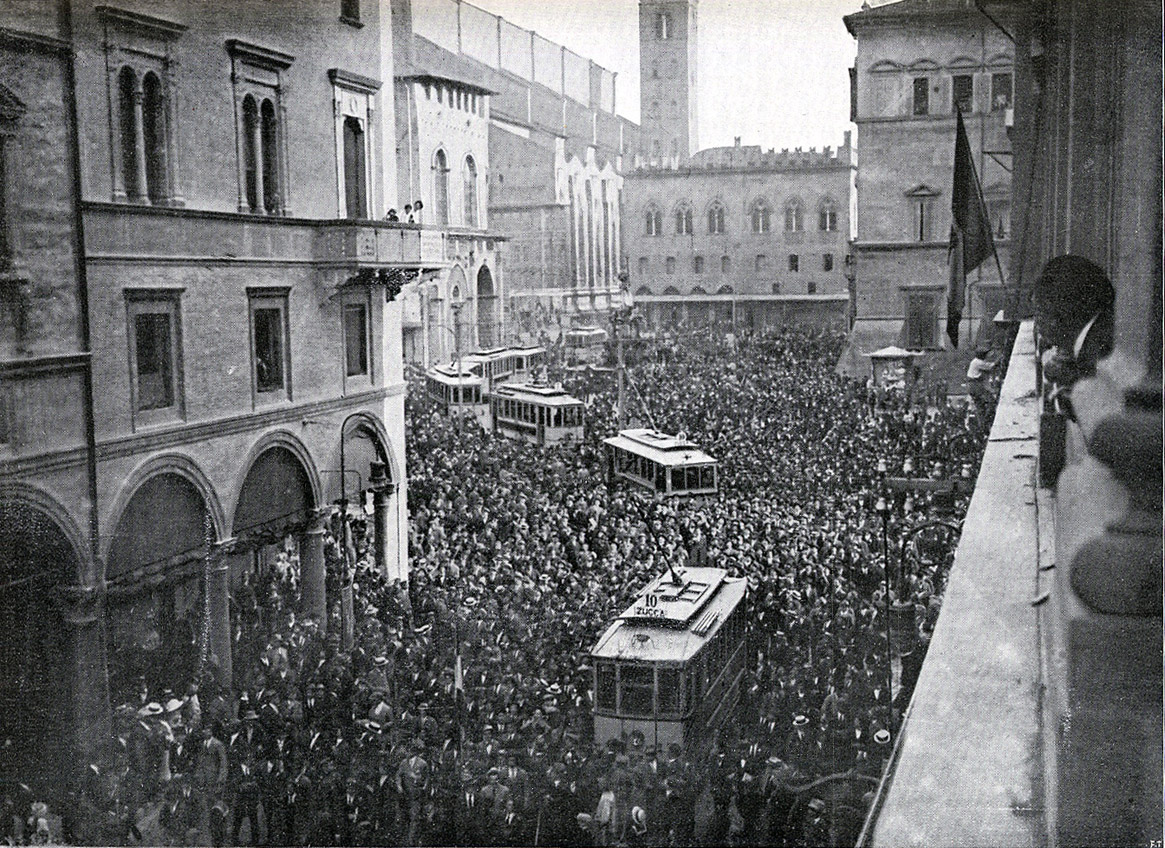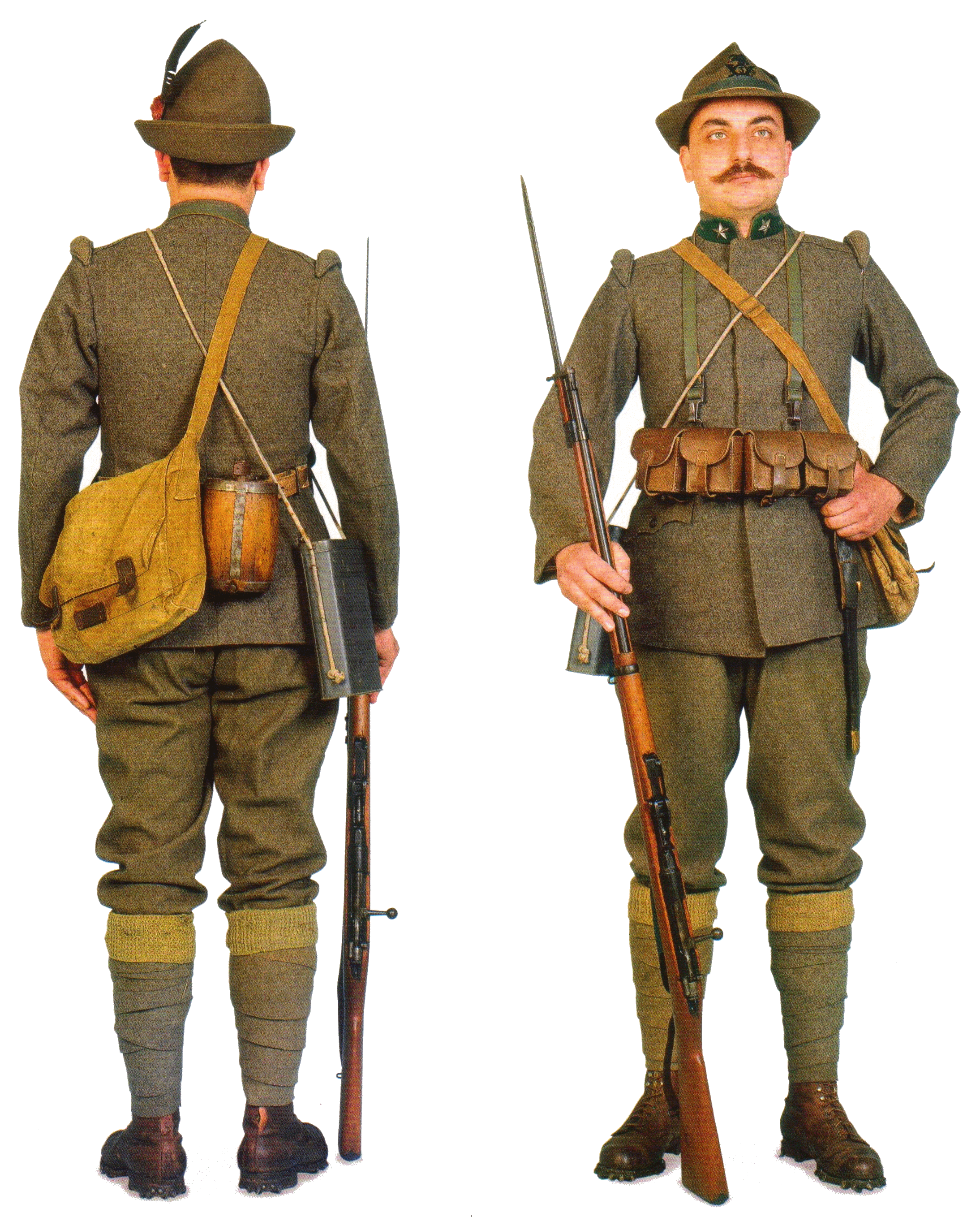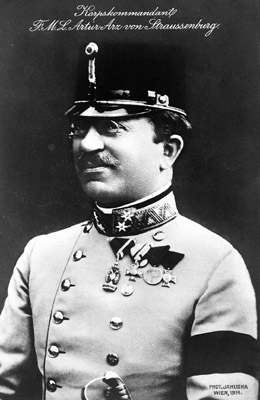|
Alpine Front
The Italian front or Alpine front ( it, Fronte alpino, "Alpine front"; in german: Gebirgskrieg, "Mountain war") involved a series of battles at the border between Austria-Hungary and Italy, fought between 1915 and 1918 in the course of World War I. Following secret promises made by the Allies in the 1915 Treaty of London, Italy entered the war aiming to annex the Austrian Littoral, northern Dalmatia, and the territories of present-day Trentino and South Tyrol. Although Italy had hoped to gain the territories with a surprise offensive, the front soon bogged down into trench warfare, similar to that on the Western Front in France, but at high altitudes and with very cold winters. Fighting along the front displaced much of the local population, and several thousand civilians died from malnutrition and illness in Italian and Austro-Hungarian refugee-camps. The Allied victory at Vittorio Veneto, the disintegration of the Habsburg empire, and the Italian capture of Trento and Triest ... [...More Info...] [...Related Items...] OR: [Wikipedia] [Google] [Baidu] |
European Theatre Of World War I
Although considerable conflict took place outside Europe, the European theatre (also known as the First European War) was the main theatre of operations during World War I and was where the war began and ended. During the four years of conflict, battle was joined by armies of unprecedented size equipped with new mechanized technologies, leaving millions dead or wounded. The European theatre is divided into four main theatres of operations: the Western Front, the Eastern Front, the Italian Front, and the Balkans Front. Not all of Europe involved in the war. Nor did fighting take place throughout all of the major combatants territory. The United Kingdom was nearly untouched by the war. Most of France was unaffected, as was most of Germany and Italy. Some large countries in Europe remained neutral for the entire war such as Sweden and Spain – the Great War passed them by without much impact. On the other hand, some countries were conquered (Serbia, Belgium, Romania). Other ... [...More Info...] [...Related Items...] OR: [Wikipedia] [Google] [Baidu] |
Luigi Cadorna
Marshal of Italy Luigi Cadorna, (4 September 1850 – 21 December 1928) was an Italian general, Marshal of Italy and Count most famous for being the Chief of Staff of the Italian Army from 1914-1917 of World War I. Early career Luigi Cadorna was born to General Raffaele Cadorna in Verbania Pallanza, Piedmont in 1850. In 1860 Cadorna became a student at the "Teuliè" Military School in Milan. At fifteen he entered the Turin Military Academy. Upon graduation he was commissioned as a second lieutenant of artillery in 1868. In 1870, as an officer in the 2nd Regiment of Artillery, Cadorna participated in the occupation of Rome as part of a force commanded by his father. As major he was appointed to the staff of General Pianell, afterwards taking the post of Chief of Staff of the Verona Divisional Command. As Colonel commanding the 10th Regiment of Bersaglieri from 1892 Cadorna acquired a reputation for strict discipline and harsh punishment. He wrote a manual of infantry tactics ... [...More Info...] [...Related Items...] OR: [Wikipedia] [Google] [Baidu] |
Saint-Michel-de-Maurienne Derailment
The Saint-Michel-de-Maurienne derailment of December 12, 1917 was a railway accident involving a troop train carrying at least 1,000 French soldiers on their way home for leave from the Italian Front in World War I. A derailment as the train descended the Maurienne valley on the Culoz–Modane railway caused a catastrophic crash and subsequent fire in which more than 675 died. It is still France's deadliest rail accident to date. Background of the accident Following the Battle of Caporetto, which took place from October 24 to November 19 1917, a British and French Expeditionary Corps was sent to northeast Italy in order to reinforce the Italian front line. When the Italian Front stabilized a month later, General Émile Fayolle, who was the new commander in chief of the French troops supporting the Italians, granted leave to soldiers who had previously fought on the Western Front so that morale would improve in the wake of the 1917 French Army mutinies. At the end of November 1 ... [...More Info...] [...Related Items...] OR: [Wikipedia] [Google] [Baidu] |
Romanian Legion Of Italy
The Romanian Legion of Italy was a military body made up of Romanian soldiers in Italy, formed in June 1918, towards the end of World War I. History In 1916 the Romanian prisoners present in Italy were divided as it follows: 3,600 in the prison camp of Mantua, 2,000 in Cavarzere, 800 in Ostiglia and 800 in Chiaravalle, zones sufficiently distant from the areas of military operations. These came from Transylvania, Banat and Bucovina. During the "Congress of Oppressed Nationalities in the Austro-Hungarian Monarchy", held in the Capitol hall in Rome between 27 March and 10 April 1918, some Romanian delegates managed to obtain the possibility of forming autonomous armed units from the Italian ones. On June 6, 1918, the "Romanian Legion of Italy" was formed with headquarters at Avezzano concentration camp. Ștefan Damian, '' War leaflets: the Romanian language in Italy in the propaganda of the First World War '', Italo-Romanian cultural horizons, n.1, January 2012, year II The ... [...More Info...] [...Related Items...] OR: [Wikipedia] [Google] [Baidu] |
Regiment
A regiment is a military unit. Its role and size varies markedly, depending on the country, service and/or a specialisation. In Medieval Europe, the term "regiment" denoted any large body of front-line soldiers, recruited or conscripted in one geographical area, by a leader who was often also the feudal lord ''in capite'' of the soldiers. Lesser barons of knightly rank could be expected to muster or hire a company or battalion from their manorial estate. By the end of the 17th century, infantry regiments in most European armies were permanent units, with approximately 800 men and commanded by a colonel. Definitions During the modern era, the word "regiment" – much like "corps" – may have two somewhat divergent meanings, which refer to two distinct roles: # a front-line military formation; or # an administrative or ceremonial unit. In many armies, the first role has been assumed by independent battalions, battlegroups, task forces, brigades and other, similarly s ... [...More Info...] [...Related Items...] OR: [Wikipedia] [Google] [Baidu] |
Czechoslovak Legion In Italy
The Czechoslovak Italian Legion was a legion of Czechoslovak volunteers formed late in World War I. The first formal Czechoslovak Volunteers Group ( cs, Československý dobrovolnický sbor) was formed in Italian prisoner-of-war camps in Santa Maria Capua Vetere, near Naples and matured at Padula near Salerno. In January 1918, the headquarters of the 6th Italian Army finally agreed to form reconnaissance squadrons from Czechoslovak and Southern Slav volunteers. In September 1918, the 39th Regiment of the Czechoslovak Italian Legion was formed from those volunteer reconnaissance squadrons. The following regiments of Czechoslovak Italian Legion were formed in April and May 1918: *31st Regiment in Perugia (Col. Ciaffi) *32nd Regiment in Assisi *33rd Regiment in Foligno (Maj. Sagone) *34th Regiment in Spoleto (Col. Gambi) *35th Regiment was formed in October 1918 from new Czechoslovak prisoners of war in Italy The Czechoslovak Italian Legion formed two divisions: VI. Division, whic ... [...More Info...] [...Related Items...] OR: [Wikipedia] [Google] [Baidu] |
Division (military)
A division is a large military unit or Formation (military), formation, usually consisting of between 6,000 and 25,000 soldiers. In most armies, a division is composed of several regiments or brigades; in turn, several divisions typically make up a corps. Historically, the division has been the default combined arms unit capable of independent Military tactics, operations. Smaller combined arms units, such as the American regimental combat team (RCT) during World War II, were used when conditions favored them. In recent times, modern Western militaries have begun adopting the smaller brigade combat team (similar to the RCT) as the default combined arms unit, with the division they belong to being less important. While the focus of this article is on army divisions, in naval usage "division (naval), division" has a completely different meaning, referring to either an administrative/functional sub-unit of a department (e.g., fire control division of the weapons department) aboar ... [...More Info...] [...Related Items...] OR: [Wikipedia] [Google] [Baidu] |
Otto Von Below
Otto Ernst Vinzent Leo von Below (18 January 1857 – 15 March 1944) served as a Prussian general officer in the Imperial German Army during the First World War (1914–1918). He arguably became most notable for his command, along with the Austro-Hungarian commander Svetozar Borojević, during the victorious Battle of Caporetto in October–November 1917. Pre-war Von Below was born in Danzig (now Gdańsk). Before the war broke out, he was promoted ''Generalmajor'' in 1909 and ''Generalleutnant'' in 1912. He was commanding the 2nd Infantry Division immediately prior to the outbreak of war. First World War Eastern Front On 1 August 1914, at the outbreak of the First World War, Below was given command of I Reserve Corps as part of 8th Army on the Eastern Front. He led his Corps in the Battles of Gumbinnen, Tannenberg, and the Masurian Lakes. As a result of his successes, he was promoted to ''General der Infanterie'' at the end of August 1914 and to command of 8th Army at th ... [...More Info...] [...Related Items...] OR: [Wikipedia] [Google] [Baidu] |
Arthur Arz Von Straußenburg
Generaloberst Arthur Freiherr Arz von Straußenburg ( hu, Báró Artúr Arz de Straussenburg; 16 June 1857 – 1 July 1935) was an Austro-Hungarian colonel general and last Chief of the General Staff of the Austro-Hungarian Army. At the outbreak of the First World War, he commanded the 15th Infantry Division. Soon, he was promoted to the head of the 6th Corps and the First Army. He participated on the Gorlice–Tarnów Offensive in 1915 and the countryside of Romania in 1916. In March 1917, he became Chief of the General Staff until his resignation on 3 November 1918. Early life Born into a Protestant family that was among the ancient Saxon settlers of east Transylvania, Arz was the product of a noble "Siebenbürger" family. His father, Albert Arz von Straußenburg, served as an evangelical preacher and curate as well as a member of the House of Magnates. Schooled in Dresden and Hermannstadt, Arz graduated "with great achievement", and went on to read law at a university, during w ... [...More Info...] [...Related Items...] OR: [Wikipedia] [Google] [Baidu] |
Svetozar Boroević
Svetozar Boroević von Bojna (or Borojević) (13 December 1856 – 23 May 1920) was an Austro-Hungarian field marshal who was described as one of the finest defensive strategists of the First World War. He commanded Austro-Hungarian forces in the Isonzo front, for which he was nicknamed the "Lion of Isonzo". For his service during the First World War, Boroević rose to the rank of '' Feldmarschall'' before the end of the war in 1918, becoming the first and only Austro-Hungarian field marshal of South Slavic descent. Life Early life Boroević was born on 13 December 1856 in the village of Umetić, Croatian Military Frontier. He was baptized in the Eastern Orthodox Church, most likely in the parish church in Mečenčani, where his father served. Some sources state that Boroević was an ethnic Serb or of Serb origin. Other sources regard him as an ethnic Croat or of Croat origin.: "A Croat (the Croats prided themselves on their particular loyalty to the emperor)." Boroević hi ... [...More Info...] [...Related Items...] OR: [Wikipedia] [Google] [Baidu] |
Conrad Von Hötzendorf
Conrad may refer to: People * Conrad (name) Places United States * Conrad, Illinois, an unincorporated community * Conrad, Indiana, an unincorporated community * Conrad, Iowa, a city * Conrad, Montana, a city * Conrad Glacier, Washington Elsewhere * Conrad, Alberta, Canada, a former unincorporated community * Conrad Mountains, Queen Maud Land, Antarctica * Mount Conrad, Oates Land, Antarctica Businesses * Conrad Editora, a Brazilian publisher * Conrad Electronic, a German retailer * Conrad Hotels, the global luxury brand of Hilton Hotels * Conrad Models, a German manufacturer of diecast toys and promotional models Other uses * ''Conrad'' (comic strip) * CONRAD (organization), an American organization which promotes reproductive health in the developing world * ORP ''Conrad'', name of the cruiser HMS ''Danae'' (D44) while loaned to the Polish Navy (1944-1946) See also * Conradi * Conradin * Conradines * Conrads (other) * Corrado (other) * Co ... [...More Info...] [...Related Items...] OR: [Wikipedia] [Google] [Baidu] |
Jean César Graziani
Jean César Graziani (; Bastia, Corsica, 15 November 1859 – Paris, 8 February 1932) was a French Army general during World War I. Early years He started his studies at the Ecole Spéciale Militaire de Saint-Cyr in October 1878. He participated in the Algerian and Tunisian campaigns and by 1909 commanded the 96th Infantry Regiment. In 1912 he became director of the Infantry at the Ministry of Defence. On 29 January 1913, by now a Brigadier General, he became head of the cabinet of the Minister of Defence. World War I One month after the outbreak of World War I, he became vice chief of the État-major of the Army and on 31 July 1915 chief of the État-major of the Army. In April 1917 he received field command of the 28th Division and in December 1917 of the 17th Army Corps. On 29 March 1918, he became commander of the 12th French Army Corps, which was stationed in Italy. At the same time, the Tenth Army returned to France, leaving only the 12th Army Corps on the Italian Fr ... [...More Info...] [...Related Items...] OR: [Wikipedia] [Google] [Baidu] |


_.jpg)


